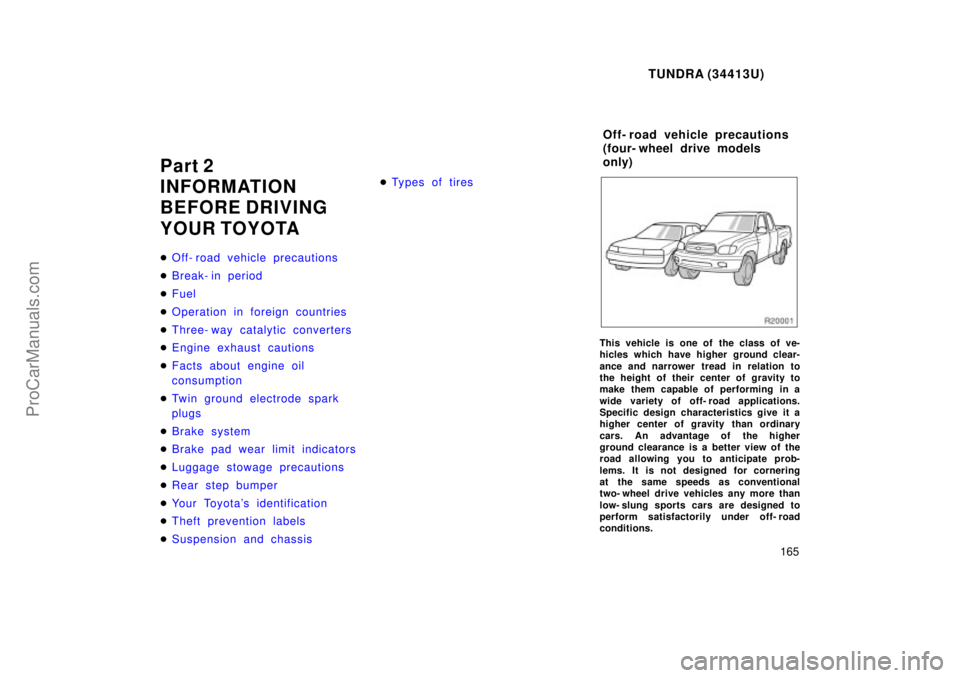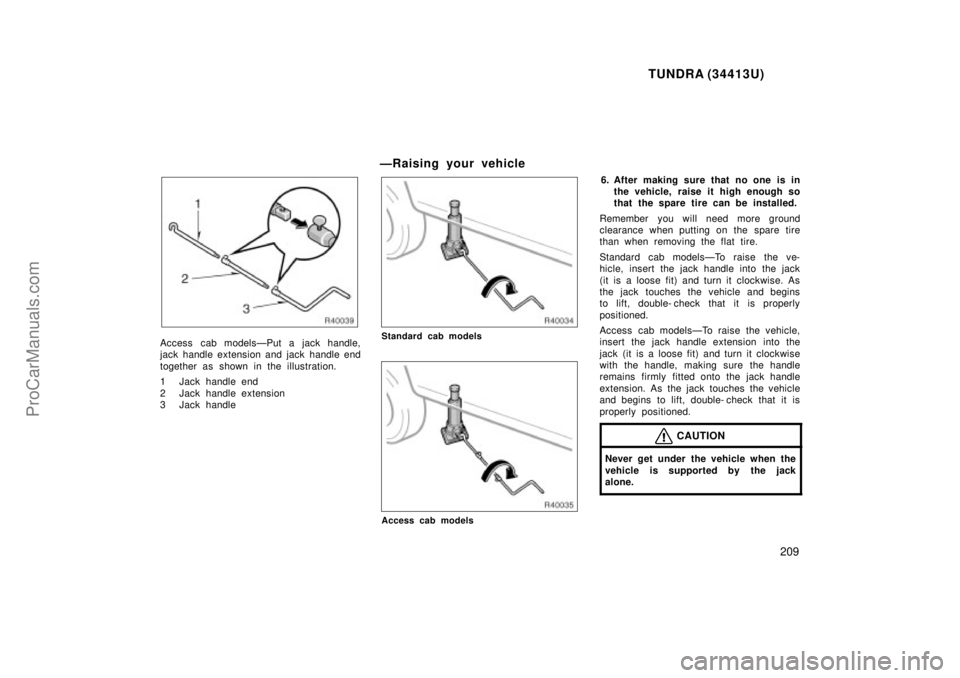Page 165 of 283

TUNDRA (34413U)
165
Part 2
INFORMATION
BEFORE DRIVING
YOUR TOYOTA
�Off- road vehicle precautions
� Break- in period
� Fuel
� Operation in foreign countries
� Three- way catalytic converters
� Engine exhaust cautions
� Facts about engine oil
consumption
� Twin ground electrode spark
plugs
� Brake system
� Brake pad wear limit indicators
� Luggage stowage precautions
� Rear step bumper
� Your Toyota's identification
� Theft prevention labels
� Suspension and chassis �
Types of tires
This vehicle is one of the class of ve-
hicles which have higher ground clear-
ance and narrower tread in relation to
the height of their center of gravity to
make them capable of performing in a
wide variety of off- road applications.
Specific design characteristics give it a
higher center of gravity than ordinary
cars. An advantage of the higher
ground clearance is a better view of the
road allowing you to anticipate prob-
lems. It is not designed for cornering
at the same speeds as conventional
two- wheel drive vehicles any more than
low- slung sports cars are designed to
perform satisfactorily under off- road
conditions.
Off- road vehicle precautions
(four- wheel drive models
only)
ProCarManuals.com
Page 209 of 283

TUNDRA (34413U)
209
Access cab modelsÐPut a jack handle,
jack handle extension and jack handle end
together as shown in the illustration.
1 Jack handle end
2 Jack handle extension
3 Jack handle
ÐRaising your vehicle
Standard cab models
Access cab models
6. After making sure that no one is inthe vehicle, raise it high enough so
that the spare tire can be installed.
Remember you will need more ground
clearance when putting on the spare tire
than when removing the flat tire.
Standard cab modelsÐTo raise the ve-
hicle, insert the jack handle into the jack
(it is a loose fit) and turn it clockwise. As
the jack touches the vehicle and begins
to lift, double- check that it is properly
positioned.
Access cab modelsÐTo raise the vehicle,
insert the jack handle extension into the
jack (it is a loose fit) and turn it clockwise
with the handle, making sure the handle
remains firmly fitted onto the jack handle
extension. As the jack touches the vehicle
and begins to lift, double- check that it is
properly positioned.
CAUTION
Never get under the vehicle when the
vehicle is supported by the jack
alone.
ProCarManuals.com
Page 213 of 283

TUNDRA (34413U)
213
If towing is necessary, we recommend
you have it done by your Toyota dealer
or a commercial tow truck service. In
consultation with them, have your ve-
hicle towed using either (a) or (b).
Only when you cannot receive a towing
service from a Toyota dealer or com-
mercial tow truck service, tow your ve-
hicle carefully in accordance with the
instructions given in ÐEmergency tow-
ingº in this part.
Proper equipment will help ensure that
your vehicle is not damaged while being
towed. Commercial operators are generally
aware of the state/provincial and local
laws pertaining to towing.
Your vehicle can be damaged if it is
towed incorrectly. Although most operators
know the correct procedure, it is possible
to make a mistake. To avoid damage to
your vehicle, make sure the following few
precautions are observed. If necessary,
show this page to the tow truck driver.
TOWING PRECAUTIONS:
Use a safety chain system for all towing,
and abide by the state/provincial and local
laws. The wheels and axle on the ground
must be in good condition. If they are
damaged, use a towing dolly.Two- wheel drive modelsÐ
(a) Towing with wheel lift type truck
From frontÐ
�Manual transmission:
We recommend using a towing dolly under
the rear wheels. If you do not use a tow-
ing dolly, release the parking brake and
put the transmission in neutral.
�Automatic transmission:
Use a towing dolly under the rear wheels.
NOTICE
Never tow a vehicle with an automatic transmission from the front with therear wheels on the ground, as thismay cause serious damage to the
transmission.
From rearÐ Place the ignition key in the
ACCº position.
NOTICE
�When lifting wheels, take care to
ensure adequate ground clearancefor towing at the opposite end ofthe raised vehicle. Otherwise, the
bumper and/or underbody of thetowed vehicle will be damaged dur-ing towing.
�Do not tow with the key removed orin the LOCKº position, as thesteering lock mechanism is not
strong enough to hold the frontwheels straight while towing.
(b) Using flat bed truck
ProCarManuals.com
Page 245 of 283

TUNDRA (34413U)
245
Check the tires regularly for damage
such as cuts, splits and cracks. If any
damage is found, consult with a techni-
cian and have the tire repaired or re-
placed.
Even if the damage does not appear seri-
ous, a qualified technician should examine
the damage. Objects which have pene-
trated the tire may have caused internal
damage.
Any tires which are over 6 years old
must be checked by a qualified techni-
cian even if damage is not obvious.
Tires deteriorate with age even if they
have never or seldom been used.
This also applies to the spare tire and
tires stored for future use.
REPLACING YOUR TIRES
When replacing a tire, use only the
same size and construction as original-
ly installed and with the same or great-
er load capacity.
Using any other size or type of tire may
seriously affect handling, ride, speedome-
ter/odometer calibration, ground clearance,
and clearance between the body and tires
or snow chains.CAUTION
�Do not mix radial, bias belted, or
bias- ply tires on your vehicle. It
can cause dangerous handling char-
acteristics, resulting in loss of con-
trol.
�Do not use tires or wheels other
than the manufacturer 's recom-
mended size.
Toyota recommends all four tires, or at
least both of the front or rear tires be
replaced at a time as a set.
See If you have a flat tireº in Part 4 for
tire change procedure.
When a tire is replaced, the wheel
should always be balanced.
An unbalanced wheel may affect vehicle
handling and tire life. Wheels can get out
of balance with regular use and should
therefore be balanced occasionally.
When replacing a tubeless tire, the air
valve should also be replaced with a
new one.
Rotating tires
With a spare tire of the same wheel type
as the installed tires
With a spare tire of different wheel type
from the installed tires
ProCarManuals.com
Page 247 of 283

TUNDRA (34413U)
247
CAUTION
�Do not exceed 50 km/h (30 mph) or
the chain manufacturer 's recom-
mended speed limit, whichever is
lower.
�Drive carefully avoiding bumps,
holes, and sharp turns, which may
cause the vehicle to bounce.
�Avoid sharp turns or locked- wheel
braking, as use of chains may ad-
versely affect vehicle handling.
Replacing wheels
WHEN TO REPLACE YOUR WHEELS
If you have wheel damage such as
bending, cracks or heavy corrosion, the
wheel should be replaced.
If you fail to replace damaged wheels, the
tire may slip off the wheel or they may
cause loss of handling control.
WHEEL SELECTION
When replacing wheels, care should be
taken to ensure that the wheels are re-
placed by ones with the same load ca-
pacity, diameter, rim width, and offset.
Correct replacement wheels are available
at your Toyota dealer.
A wheel of a different size or type may
adversely affect handling, wheel and bear-
ing life, brake cooling, speedometer/odom-
eter calibration, stopping ability, headlight
aim, bumper height, vehicle ground clear-
ance, and tire or snow chain clearance to
the body and chassis. Replacement with used wheels is not rec-
ommended as they may have been sub-
jected to rough treatment or high mileage
and could fail without warning. Also, bent
wheels which have been straightened may
have structural damage and therefore
should not be used. Never use an inner
tube in a leaking wheel which is designed
for a tubeless tire.
ProCarManuals.com